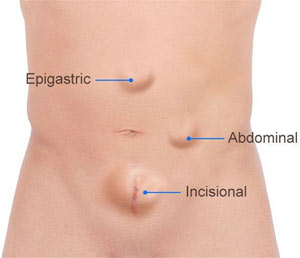Our Services

Dr. Gaurav Bansal
MBBS, MS - General Surgery, FIAGES - Minimal Access Surgery, Fellowship in Advanced Minimally Invasive and Robotic Surgery.
View Full Profile
Abdominal Wall (Ventral) Hernia Surgery
What is a ventral hernia?

A ventral hernia is a bulge of tissues through an opening of weakness within your abdominal wall muscles. It can occur at any location on your abdominal wall.
Abdominal Wall Hernia:-
- Ventral:- the phrase is used for abdominal wall related hernias, not for the groin
- Umbilical Hernia:- It occurs in belly button when part of small bowel pushes through the abdominal wall close to navel or belly button.
- An epigastric Hernia:- It occurs between the belly button and breastbone.
- Spigelian: It occurs when intestine pushed through outside edges of rectus abdomen muscle and it is rarely found.
- Incisional Hernia: they are formed at the healed site of past surgical incisions. Here abdominal wall layers have become weak or thin, allowing for abdominal cavity contents to push through.
Risk factors
What are the risk factors of a ventral hernia?
- congenital defect — one existing from birth
- pregnancy
- obesity
- history of previous hernias
- history of abdominal surgeries
- family history of hernias
- frequently lifting or pushing heavy objects
What are the causes of a ventral hernia?
Incisional hernias may occur in up to 30 percent of those who’ve had an abdominal surgery. Most occur at the site of a surgical scar. The scar tissue weakens or thins, allowing a bulge to form in the abdomen. This bulge is tissue or organs pushing against the abdominal wall.
What are the symptoms of this condition?
- Asymptomatic
- mild discomfort in your abdominal area
- pain in your abdomen
- outward bulging of skin or tissues in your abdominal area
- nausea
- vomiting
How is a ventral hernia diagnosed?
- physical examination
- abdominal ultrasound
- abdominal CT scan
- abdominal MRI scan
What treatment options are available?
Ventral hernias require surgical correction.
If left untreated, they continue to grow slowly until they are able to cause serious complications.
Untreated hernias can grow into enlarged ventral hernias that become progressively more difficult to fix.
Swelling can lead to trapping of hernia contents, a process called incarceration. This in turn can lead to reduced or no blood supply to the tissues involved, which is referred to as strangulation.
Options for surgical treatment include:
- Mesh placement surgery: A surgeon pushes tissue back into place and then sews in a mesh, which serves as a reinforcing patch, to keep it in place. This is considered safe and reliable, and mesh placement has been shown to reduce risk of hernia recurrence.
- Laparoscopic repair: A surgeon makes e small openings and fixes your hernia using guidance with a small camera inside your body to direct the surgery. A mesh may or may not be used.
- Open surgery (nonlaparoscopic): A surgeon makes an incision adjacent to your hernia, pushes the tissues back into place, and then sews the area shut. A mesh may or may not be used.
Benefits of laparoscopic removal include the following:
- much smaller cut site, which lowers chance of infection
- reduced postoperative pain
- reduced hospital stay — generally able to leave day of or day after procedure
- absence of a large scar
- faster overall recovery time
- complete general anaesthesia
- dual light weight mesh
These are a few concerns about open surgery:
- longer stay in the hospital after surgery
- greater amount of pain
- medium to large scar
Complications
Are there complications?
Massive ventral hernias are difficult to fix
- Incarceration: Your intestine becomes trapped in a weak abdomen wall where it can’t be pushed back inside of your abdominal cavity. This may cause blockage to your intestine or cut off its blood supply.
- Strangulation: This occurs when blood flow to your intestine is blocked. Part of your intestine may die or begin to decay. Immediate surgery is necessary to restore blood flow and save the intestine.
The outlook is generally very good after a surgery with no complications. You may need to rest for a few weeks before resuming daily activities, avoiding any heavy lifting or straining to the abdominal area.

